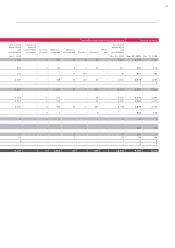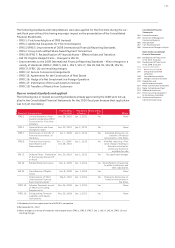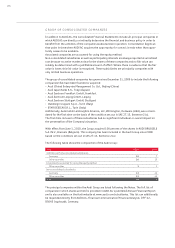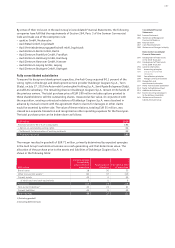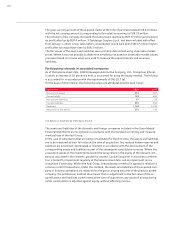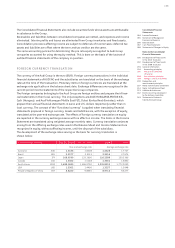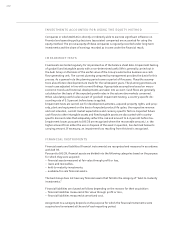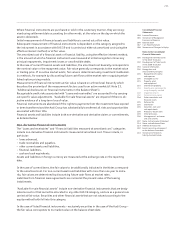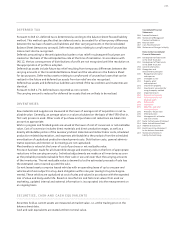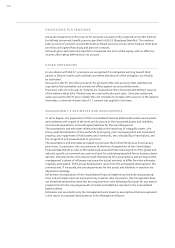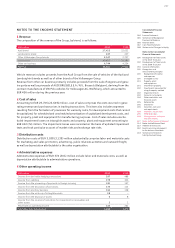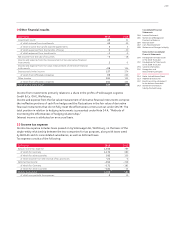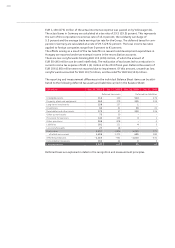Audi 2010 Annual Report Download - page 205
Download and view the complete annual report
Please find page 205 of the 2010 Audi annual report below. You can navigate through the pages in the report by either clicking on the pages listed below, or by using the keyword search tool below to find specific information within the annual report.
203
Consolidated Financial
Statements
184 Income Statement
185 Statement of Recognized
Income and Expense
186 Balance Sheet
187 Cash Flow Statement
188 Statement of Changes in Equity
Notes to the Consolidated
Financial Statements
190 Development of fixed assets
in the 2010 fiscal year
192 Development of fixed assets
in the 2009 fiscal year
194 General information
200 Recognition and
measurement principles
200 Recognition of income
and expenses
200 Intangible assets
201 Property, plant
and equipment
201 Investment property
202 Investments accounted for
using the equity method
202 Impairment tests
202 Financial instruments
204 Other receivables and
financial assets
205 Deferred tax
205 Inventories
205 Securities, cash and
cash equivalents
206 Provisions for pensions
206 Other provisions
206 Management’s estimates
and assessments
207 Notes to the Income Statement
214 Notes to the Balance Sheet
223 Additional disclosures
242 Events occurring subsequent
to the balance sheet date
243 Statement of Interests
held by the Audi Group
Where financial instruments are purchased or sold in the customary manner, they are recog-
nized using settlement date accounting (in other words, at the value on the day on which the
asset is delivered).
Initial measurement of financial assets and liabilities is carried out at fair value.
Subsequent measurement of financial instruments is dependent on the category assigned to
the instrument in accordance with IAS 39 and is carried out either at amortized cost (using the
effective interest method) or at fair value.
The amortized cost of a financial asset or financial liability, using the effective interest method,
is the amount at which a financial instrument was measured at initial recognition minus any
principal repayments, impairment losses or uncollectible debts.
In the case of current financial assets and liabilities, the amortized cost basically corresponds to
the nominal value or the repayment value. Fair value generally corresponds to the market value
or trading price. If no active market exists, fair value is determined using investment mathemat-
ics methods, for example by discounting future cash flows at the market rate or applying estab-
lished option pricing models.
Measurement of financial instruments at fair value is based on a three-level hierarchy which
describes the proximity of the measurement factors used to an active market (cf. Note 33,
“Additional disclosures on financial instruments in the Balance Sheet”).
Recognizable credit risks associated with “Loans and receivables” are accounted for by carrying
out specific value adjustments. “Available-for-sale financial assets” are impaired if there is ob-
jective evidence of a long-term loss of value.
Financial instruments are abandoned if the rights to payments from the investment have expired
or been transferred and the Audi Group has substantially transferred all risks and opportunities
associated with their title.
Financial assets and liabilities include both non-derivative and derivative claims or commitments,
as detailed below.
Non-derivative financial instruments
The “Loans and receivables” and “Financial liabilities measured at amortized cost” categories
include non-derivative financial instruments measured at amortized cost. These include, in
particular:
– loans advanced,
– trade receivables and payables,
– other current assets and liabilities,
– financial liabilities,
– cash and cash equivalents.
Assets and liabilities in foreign currency are measured at the exchange rate on the reporting
date.
In the case of current items, the fair values to be additionally indicated in the Notes correspond
to the amortized cost. For non-current assets and liabilities with more than one year to matu-
rity, fair values are determined by discounting future cash flows at market rates.
Liabilities from financial lease agreements are carried at the present value of the leasing
installments.
“Available-for-sale financial assets” include non-derivative financial instruments that are desig-
nated as such or that cannot be allocated to any other IAS 39 category, and are as a general rule
carried at fair value. Securities and other financial assets that are not valued according to the
equity method both fall into this category.
In the case of listed financial instruments – exclusively securities in the case of the Audi Group –
the fair value corresponds to its market value on the balance sheet date.


